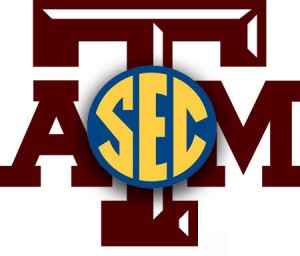Texas A&M to the SEC: Considering Conference Realignment Scenarios
Posted by rtmsf on September 7th, 2011Andrew Murawa is the RTC correspondent for the Pac-12 and Mountain West conferences and a frequent contributor.
For more than a year now, college sports fans have looked on with some mixture of fascination, excitement, disgust and horror as conferences and their member institutions have played a game of chicken with all-out conference-realignment Armageddon. Last June, following Nebraska’s announcement that it was leaving for the Big Ten, the Big 12 was on the verge of extinction when a quartet of teams led by Texas strongly considered a move west to form the first superconference, the Pac-16. However, after a weekend on the edge of the wire, they backed away and recommitted to the Big 12. But now, with Texas A&M’s slow-motion defection from the Big 12 to the SEC all but finished, the Big 12 is in another fight for its survival, with athletic directors and conference commissioners around the country considering their options should the Big 12 dissolve.
The first big domino here is obviously Texas A&M. They formally announced last week that they intend to leave the Big 12 Conference by July 2012, and the school is expected to announce later today that the SEC is their landing spot. Reportedly the 12 existing SEC schools voted 10-2 Tuesday night in favor of inviting the Aggies to its league, but a formal announcement could potentially hit a snag if any of the other nine remaining Big 12 schools chooses to not waive its right to litigate against the SEC for tortious interference with its conference affiliation.
Assuming no holdups from there (a big assumption: Baylor and Ken Starr in particular may have some issues), things could get considerably more dicey, and quickly. With A&M gone, the Big 12 would be down to nine teams. Provided that the remaining nine teams were still committed to the league, it could be saved by wooing BYU or TCU or even slumming it with SMU or Rice (no offense to SMU or Rice). The big problem for the Big 12, however, seems to be that there are other schools among the remaining nine who are getting antsy. Oklahoma, in particular, appears to have had enough of the instability in the Big 12, as university president David Boren told The Oklahoman on Friday, “We obviously want stability in our conference relationships. We want partners that are outstanding, both athletically and academically. A conference that’s strong is not only stable, but it’s one in which there are multiple relationships, along with sports, between university members.” If Oklahoma is displeased with the Big 12, there are plenty of willing suitors out there for them, but more importantly, if OU is ready to jump ship, that likely means the Big 12 is done. The most likely move for the Sooners is west to the Pac-12, at the very least along with Oklahoma State, and possibly with Texas and Texas Tech in tow as well.
The Longhorns would be a major get for any conference, and have been mentioned at least in passing with the Pac-12, SEC and even ACC. However, the ink is barely even dry on Texas’ new agreement with ESPN to form the Longhorn Network, a UT-based cable network that just launched less than two weeks ago, and in order to join the Pac-12 the LHN would need to be re-imagined as a regional network. This would force the university to share those future profits with a regional partner, in the above scenario, Texas Tech. Given Texas’ history of asking for, and getting, preferential treatment in its conference affiliations, sharing the fruits of the LHN with the likes of Texas Tech could be a non-starter. Another possibility is for the school to go independent in football (something the Longhorn gridiron program could definitely pull off) while finding a suitable temporary parking spot for its basketball and Olympic sports. Unfortunately, it is unlikely that any other major conference would take on the Longhorns as a member without the huge benefit of adding their football team as well.
The other domino ripe for fairly immediate toppling would be the SEC’s potential 14th team. Names like Florida State, Virginia Tech, Clemson, Missouri, West Virginia and other increasingly more unfeasible options have popped up, but the SEC has not been forthcoming about its thinking, and some of those universities, namely Virginia Tech and Missouri, have outright denied the idea that they would be interested in joining the SEC. However, if 44.4% of the remaining Big 12 teams have plans on the West Coast, Mizzou administrators might be forced to reconsider. And Dennis Dodd tweeted on Tuesday afternoon that, in fact, Missouri and West Virginia were the favorites for the next SEC spot.
Assuming the Pac-16 occurs, that means the Big 12 crumbles and there is a free-for-all for the remaining schools: Baylor, Iowa State, Kansas and Kansas State, aside from Missouri. Of those first four, Kansas is the most attractive and there have already been rumors about the Jayhawks heading to the Big East, making an already insane basketball conference even stronger, especially if Kansas State joins the Jayhawks as a regional traveling partner of sorts. Unfortunately, that would also mean a 19-team basketball conference, making anything approaching a reasonable schedule a virtual impossibility. Meanwhile, Baylor and Iowa State may be left twisting in the wind (which I swear was not meant to be a Cyclone pun), with possible Mountain West and Conference USA landing spots being a definite downgrade from the Big 12.
Elsewhere around the country, the ACC has been rumored to be considering pre-emptive strikes, what with schools like Clemson, Florida State and Virginia Tech at least on the radar of the SEC. The most fantastical rumor came from Chip Brown who claimed a source who had the ACC targeting Texas along with Connecticut, Rutgers and Syracuse from the Big East, an idea that had college basketball fans slobbering all over themselves on Labor Day evening. Imagine an Atlantic Coast Conference featuring college basketball powers like UConn, Syracuse and perennially talented but underachieving Texas to pair with college basketball bluebloods Duke and North Carolina and the rest of the normally strong ACC.
The Big Ten, which frankly got this whole ball rolling last spring, at least for now looks ready to stand pat, with commissioner Jim Delaney saying that “it’s about quality and not quantity.” Reading the tea leaves there, unless Notre Dame has a change of heart about becoming a member of the Big Ten in all sports, the conference is likely done expanding for the near future.
And then there’s the Big East, which has been trying to grow its football side of the ledger in an effort to stave off BCS irrelevance. Big 12 castoffs like Iowa State, Kansas and Kansas State are going to do nothing to improve its gridiron stature (not to mention travel budgets) and given its poor reputation as a football league, it is more likely to lose teams than they are to be able to poach teams from other BCS conferences. If the talk about all of this conference realignment eventually leading to four 16-team conferences is accurate, it looks like the Big East is running a distant fifth in the race for the top four spots. For college hoops fans, that’s a scary proposition, meaning the depth of the conference on the hardwood could take a big hit in the coming years. If schools like Syracuse and Connecticut (along with Rutgers) head to the ACC, the other remaining football schools (Cincinnati, Louisville, Pittsburgh, South Florida and West Virginia, not to mention soon-to-be member TCU) will be forced to look for more prosperous homes for their gridiron teams, possibly sending the Big East back to a basketball-only conference of like-minded Catholic schools: Georgetown, Villanova, St. John’s, Providence, Seton Hall, Marquette, DePaul and Notre Dame. Along the way we’d lose a couple more rivalries, with Georgetown/Syracuse (among others) gone the way of the Oklahoma/Nebraska and Nebraska/Texas football rivalries, much the way the Texas/Texas A&M rivalry also seems poised to disappear.
And of course, from there we will have even more changes trickle down to other conferences in Division I basketball, with leagues like CUSA, the MW, the MAC and the Sun Belt perhaps adding some of the leftovers from the BCS conference shuffle. In the meantime, we may wind up with Oklahoma and Oklahoma State in a conference with “Pacific” in its title, TCU and Kansas as part of the wild, wild, um, East, and Texas claiming membership in an Atlantic Coast assemblage. Apart from the inanity of such pairings, we’re going to see swim teams and tennis clubs with absurd travel budgets, sharing rivals across the country, and with even more missed classes. And in a sport like college basketball played in the middle of winter, we may see more games cancelled due to an inability for one team to get to their opponent’s campus in the middle of a storm. While some of these moves may bring in more money for the schools and conferences involved, are the changes good for college sports? With these moves being made largely with an eye only on football, can college basketball get by unscathed? Sure, new rivalries will come along and replace some of the ones that fade into the oblivion, but is a college football season without an A&M/Texas battle on Thanksgiving weekend really worth it? Is a Big East basketball schedule without a Syracuse/Georgetown game or two something we really want to see? And is anybody in this whole mess really thinking about the student-athlete? The smart money is on the “no” response to each of those question, but it also is resigned to the fact that these changes are coming in some form or another, with only the timing up for debate.













































